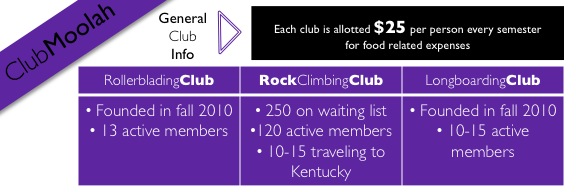It’s one step to create an official club at St. Thomas. It’s another step to get funding for it. As the number of new and unique clubs continues to grow, the trickier it gets to decide how much funding each new club should receive.
Juniors Andrea Greamba and Melena Nelson founded the Rollerblading Club in fall 2010. They said they enjoyed blading around St. Thomas and wanted to start a club so they could meet people with similar interests.
“We loved getting out in the community and rollerblading and saw that there seemed to be a lot of others who enjoyed it as well,” Nelson said.
Greamba said there are about 13 dedicated members in the club. The rollerblade on paths around St. Thomas when the weather is nice and go to the Metrodome in the winter.
That’s where the funding and the “moolah” come into the picture.
Quinn Abraham, vice president of finance for the Undergraduate Student Government, said the budget request process is pretty easy and encourages all clubs to file a budget request each semester.
“We have a finance committee with a diverse background of students who are either involved or knowledgeable about financing that help us decide how much money each club is given,” Abraham said. “We go line-by-line figuring out what we are able to fund and maybe what cannot be funded.”
When it comes to getting funded, Abraham said the biggest mistake clubs make is not updating their member lists on Murphy Online.
“I have to go off of that to judge club membership totals,” Abraham said. “For example, each club gets $25 per person each semester for food related expenses. If a club has increased its members and didn’t update the list, you are potentially not getting as much as you potentially could.”
The committee also doesn’t typically fund items that students can take home with them each year.
“For the budget request, we didn’t need to ask for a lot of money because most of our activities are outdoors,” Nelson said.
Nelson said most of the money the Rollerblading Club receives goes toward paying for admission and skate rentals at the Metrodome for its bi-weekly “meetings” in the winters.
“This year, however, we spent some of our funds on buying tickets to see the Minnesota Roller Girls which was really fun,” Greamba said.
The process to receive funding for the Rollerblading Club was relatively simple, but it has been more complicated for clubs such as the Rock Climbing Club and Long Boarding Club.
Junior Bobby Ranallo, president of the Rock Climbing Club, said the more popular the sport gets, the more people are becoming interested in joining the club.
“We have about 250 people on the mailing list; 120 of them come to meetings regularly,” Ranallo said.
Meetings for rock climbers consist of transporting members to Vertical Endeavors twice a week to climb.
“We are a take-action club,” Ranallo said. “We don’t really need money for food or anything because we don’t have sit-down meetings.”
The Rock Climbing Club was able to gather enough funding to schedule a trip to Kentucky over spring break this year. Ranallo said he is very grateful for the opportunity.
“We are taking between 10 to 15 people to Kentucky which is really exciting,” Ranallo said. “We did have to fill out a special request form that covered a good sum, and then we had to take some out of our club budget, as well as our own pockets to cover the rest.”
The Longboarding Club was founded in fall 2010 by its president junior Gary Wong, and he said he had a difficult time with the budget process.
“For our first semester as a club, we tried requesting the maximum budget we were allowed to just because we were a new club,” Wong said. “They only gave us a little more than half of what we requested because we didn’t have a lot of members yet.”
There is now a dedicated number of 10-15 students involved in the Longboarding Club, and the club is able to purchase a few long boards and helmets every year.
“Because the club doesn’t really function a whole lot in the winter, we use our money for equipment and then food when we all get together,” Wong said.
Similar to the Rock Climbing Club, Longboarding members spend their meetings looking for unique and fun places to hone their skills.
“Longboarding is, in a way, a kind of lifestyle on its own,” Wong said. “It’s really chill and relaxing; it’s a good way to meet new people who enjoy it too.”
“We try to fund things that fit with the overall club mission,” Abraham said. “We understand that not every club is going to walk away at the end of the day and say they learned something.”
Abraham also said that the club atmosphere should be more about the experience for students and less about the money.
“The most important aspect of clubs on campus is to serve as a grounds to meet people,” Abraham said. “It’s really what the college experience is all about; we try to create funding for clubs for whatever they want to do.”
Terese Quarberg can be reached at quar3707@stthomas.edu.


Your articles are very bright and informative. I enjoy reading them. I still haven’t figured out how to get your video news on adobe flash. Grammy